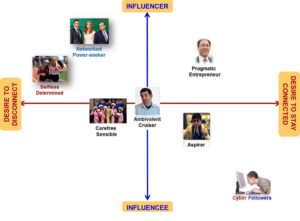Objective
The objective was to develop a segmentation algorithm on the basis of a set of psychographic attributes like basic values, beliefs, attitudes, perceptions, motivations and needs (functional, emotional, social and situational) in order to embark on targeted marketing and to enable positioning strategies.
Approach
An online survey was conducted in six Asia Pacific countries: Singapore, Philippines, Indonesia, Malaysia, Vietnam and Thailand. Responses were captured on 120 psychographic attributes related to society and politics, national sentiments, race, religion, family, consumption and purchasing, savings and investment, health, work/days off, self-expression, “vision of my future” and ecology.
These inter-correlated attributes were condensed to a number of composites using data reduction techniques (factor analysis) and these composites were then used to create clusters. These clusters were profiled and dimensioned.

Customer segments on desire for digital connectivity Vs ability to influence
The solution was fine-tuned. Non-essential attributes, those which do not contribute to the classification, were dropped iteratively. Consequently, the algorithm can now be used for future classifications of respondents.
Impact
Using this information, the client was enabled to define positioning strategies for each single product for each of their relevant segments.



